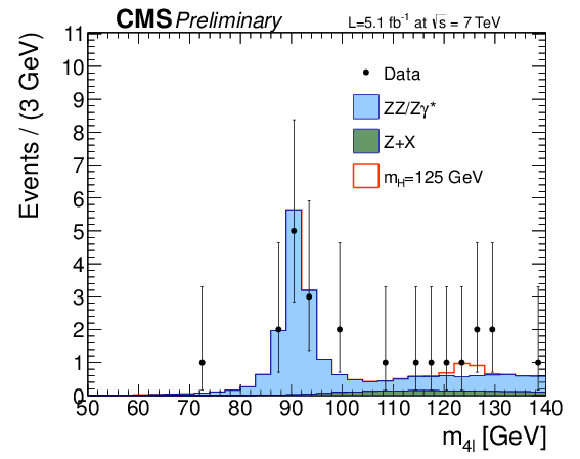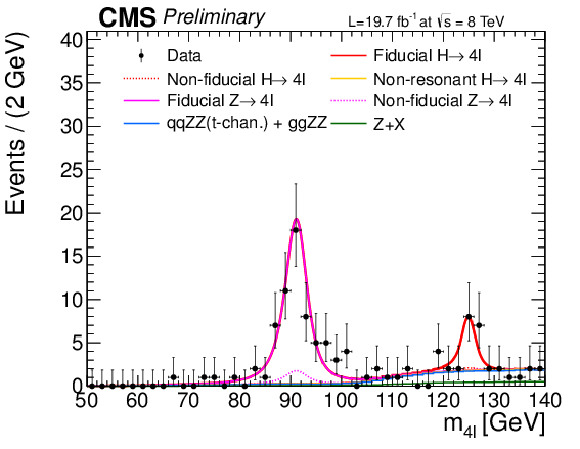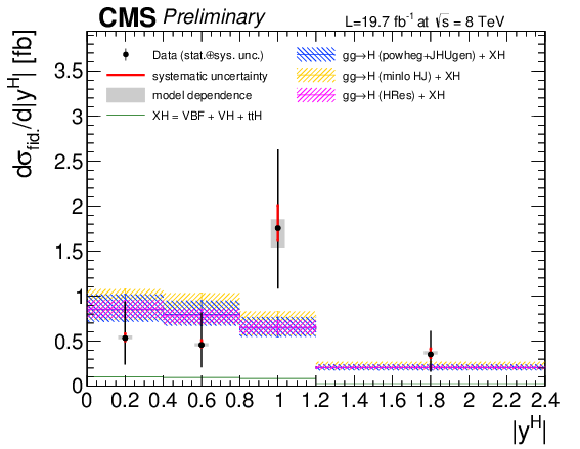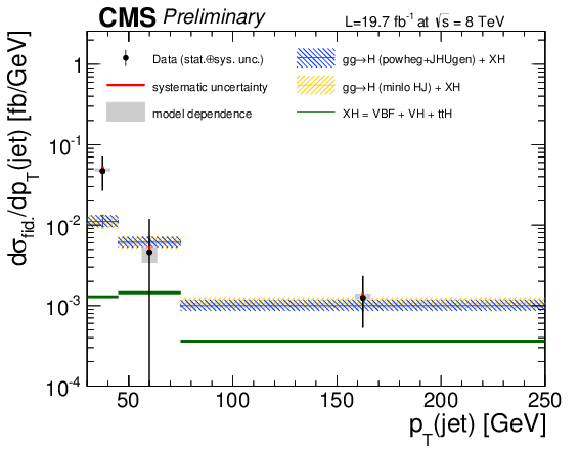

Compact Muon Solenoid
LHC, CERN
| CMS-PAS-HIG-14-028 | ||
| Measurement of inclusive and differential fiducial cross sections for Higgs boson production in the $ \mathrm{H} \to 4 \ell$ decay channel in pp collisions at $\sqrt{s} =$ 7 TeV and 8 TeV | ||
| CMS Collaboration | ||
| August 2015 | ||
| Abstract: Measurements of the inclusive and differential fiducial cross sections for Higgs boson production in pp collisions at center-of-mass energies of $\sqrt{s}= $ 7 TeV and 8 TeV using $ \mathrm{H} \rightarrow 4\ell$ decays ($\ell = e, \mu$) are presented. Measurements are based on 5.1 fb$^{-1}$ (19.7 fb$^{-1}$) of 7 (8) TeV proton-proton collision data, recorded with the CMS detector at the LHC. The measurements of differential cross section are performed in bins of the transverse momentum and rapidity of the four-lepton system, jet multiplicity, transverse momentum of the leading jet, and distance in rapidity between the Higgs boson candidate and the leading jet. A measurement of the cross section of Z boson production in the $\mathrm{Z} \rightarrow 4\ell$ decay channel and its ratio to the Higgs boson production cross section in the $\mathrm{H} \rightarrow 4\ell$ channel is also performed. The inclusive fiducial cross section for Higgs boson production in the $\mathrm{H}\rightarrow 4\ell$ decay channel is measured to be 0.56$^{+0.67}_{\rm -0.44}$ (stat) $^{+0.21}_{-0.06}$ (syst) fb for proton-proton collisions at 7 TeV and 1.11$^{+0.41}_{-0.35}$ (stat) $^{+0.14}_{-0.10}$ (syst) fb for proton-proton collisions at 8 TeV. The results of all measurements are compared with theoretical calculations based on the Standard Model and no significant deviation is observed. | ||
|
Links:
CDS record (PDF) ;
CADI line (restricted) ; Figures are also available from the CDS record. These preliminary results are superseded in this paper, JHEP 04 (2016) 005. |
||
| Figures | |

png ; pdf |
Figure 1-a:
Distributions of the $m_{4\ell }$ observable in 7 TeV (a) and 8 TeV (b) datasets, as well as expectations for the SM Higgs boson ($m_{\mathrm{H}}= $ 125.0 GeV) and contributing SM processes, including resonant $ {\mathrm {Z}\to 4\ell }$ decays. |

png ; pdf |
Figure 1-b:
Distributions of the $m_{4\ell }$ observable in 7 TeV (a) and 8 TeV (b) datasets, as well as expectations for the SM Higgs boson ($m_{\mathrm{H}}= $ 125.0 GeV) and contributing SM processes, including resonant $ {\mathrm {Z}\to 4\ell }$ decays. |

png ; pdf |
Figure 2-a:
Observed inclusive four lepton mass distribution and the resulting fits of the signal and background models, presented in Section 6, in case of an independent $ \mathrm{H} \to 4\ell $ fit (a) and a simultaneous $ \mathrm {H}\to 4\ell $ and $ \mathrm {Z}\to 4\ell $ fit (b). The $ \mathrm{ gg \to H \to 4\ell } $ process is modelled using POWHEG+JHUgen, while $ \mathrm{ q \bar{q} \to Z \to 4\ell } $ process is modelled using POWHEG, as discussed in Section 3. |

png ; pdf |
Figure 2-b:
Observed inclusive four lepton mass distribution and the resulting fits of the signal and background models, presented in Section 6, in case of an independent $ \mathrm{H} \to 4\ell $ fit (a) and a simultaneous $ \mathrm {H}\to 4\ell $ and $ \mathrm {Z}\to 4\ell $ fit (b). The $ \mathrm{ gg \to H \to 4\ell } $ process is modelled using POWHEG+JHUgen, while $ \mathrm{ q \bar{q} \to Z \to 4\ell } $ process is modelled using POWHEG, as discussed in Section 3. |

png ; pdf |
Figure 3:
Results of the inclusive $ {\mathrm {H}\to 4\ell }$ fiducial cross section measurements at proton-proton collisions at 7 and 8TeV, and comparison to the theoretical estimates. The red error bar represents the systematic uncertainty, while the black error bar represents the combined statistical and systematic uncertainties, summed in quadrature. The additional systematic effect associated with the model dependence is separately represented by a grey box. Theoretical estimations at the NNLL+NNLO accuracy and the corresponding systematic uncertainties are shown in blue as a function of the centre-of-mass energy. The acceptance of the dominant $ \mathrm{ gg \to H }$ contribution is modelled at the parton level using HRes, and corrected for the hadronisation and underlying event effects which are estimated using POWHEG+JHUgen and Pythia 6.4. |

png ; pdf |
Figure 4-a:
Results of the differential $ {\mathrm {H}\to 4\ell }$ fiducial cross section measurements and comparison to the theoretical estimates for the transverse momentum (a) and the rapidity (b) of the four-lepton system. The red error bars represent the systematic uncertainties, while black error bars represent the combined statistical and systematic uncertainties, summed in quadrature. The additional systematic uncertainty associated with the model dependence is separately represented by the grey boxes. Theoretical estimations, where the acceptance of the dominant $ \mathrm{ gg \to H }$ contribution is modelled by HRes, POWHEG+JHUgen+Pythia and POWHEG + minlo-HJ+Pythia generators as discussed in Section 3, are shown in pink, blue and yellow respectively. The sub-dominant component of the signal $\mathrm {XH = VBF + VH + t\bar{t}H } $ is indicated separately in green. In all estimations the total inclusive cross section is normalised to the SM estimate computed at NNLL+NNLO accuracy. Systematic uncertainties correspond to the accuracy of the generators used to derive the differential predictions. |

png ; pdf |
Figure 4-b:
Results of the differential $ {\mathrm {H}\to 4\ell }$ fiducial cross section measurements and comparison to the theoretical estimates for the transverse momentum (a) and the rapidity (b) of the four-lepton system. The red error bars represent the systematic uncertainties, while black error bars represent the combined statistical and systematic uncertainties, summed in quadrature. The additional systematic uncertainty associated with the model dependence is separately represented by the grey boxes. Theoretical estimations, where the acceptance of the dominant $ \mathrm{ gg \to H }$ contribution is modelled by HRes, POWHEG+JHUgen+Pythia and POWHEG + minlo-HJ+Pythia generators as discussed in Section 3, are shown in pink, blue and yellow respectively. The sub-dominant component of the signal $\mathrm {XH = VBF + VH + t\bar{t}H } $ is indicated separately in green. In all estimations the total inclusive cross section is normalised to the SM estimate computed at NNLL+NNLO accuracy. Systematic uncertainties correspond to the accuracy of the generators used to derive the differential predictions. |

png ; pdf |
Figure 5-a:
Results of the differential $ \mathrm {H \to 4\ell }$ fiducial cross section measurements and comparison to the theoretical estimates for the transverse momentum of the leading jet (a), separation in rapidity between the Higgs boson candidate and the leading jet (b), as well as for the jet multiplicity (c). Theoretical estimations, where the acceptance of the dominant $ \mathrm{ gg \to H }$ contribution is modelled by POWHEG+JHUgen+Pythia and POWHEG minlo-HJ+Pythia generators as discussed in Section 3, are shown in blue and yellow respectively. The other details are identical to those in the caption of figure 4. |

png ; pdf |
Figure 5-b:
Results of the differential $ \mathrm {H \to 4\ell }$ fiducial cross section measurements and comparison to the theoretical estimates for the transverse momentum of the leading jet (a), separation in rapidity between the Higgs boson candidate and the leading jet (b), as well as for the jet multiplicity (c). Theoretical estimations, where the acceptance of the dominant $ \mathrm{ gg \to H }$ contribution is modelled by POWHEG+JHUgen+Pythia and POWHEG minlo-HJ+Pythia generators as discussed in Section 3, are shown in blue and yellow respectively. The other details are identical to those in the caption of figure 4. |

png ; pdf |
Figure 5-c:
Results of the differential $ \mathrm {H \to 4\ell }$ fiducial cross section measurements and comparison to the theoretical estimates for the transverse momentum of the leading jet (a), separation in rapidity between the Higgs boson candidate and the leading jet (b), as well as for the jet multiplicity (c). Theoretical estimations, where the acceptance of the dominant $ \mathrm{ gg \to H }$ contribution is modelled by POWHEG+JHUgen+Pythia and POWHEG minlo-HJ+Pythia generators as discussed in Section 3, are shown in blue and yellow respectively. The other details are identical to those in the caption of figure 4. |

|
Compact Muon Solenoid LHC, CERN |

|

|

|

|

|

|